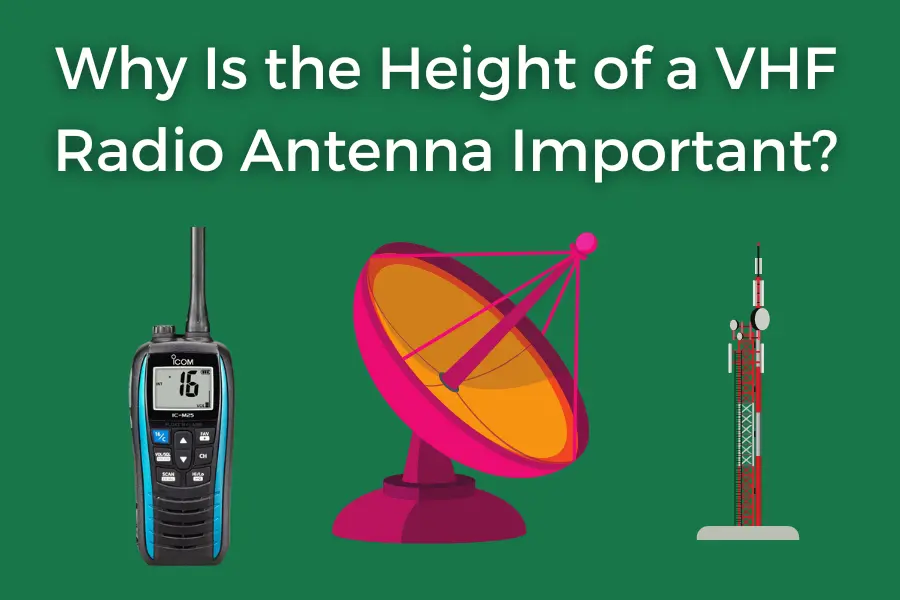Even in an age when just about any type of information is a few keystrokes or mouse clicks away, one of the most reliable forms of communication is VHF (very high frequency) radio. But even though VHF radio plays such a vital role in a wide variety of applications, it does have its limitations. Most notably, the effectiveness of VHF radio communication depends heavily on the height of the antenna. But why?
Because VHF radio communication operates on line-of-sight transmission, its effectiveness depends on a clear, unobstructed path from the transmitting antenna to the receiving antenna. VHF radio’s straight-line transmission also improves greatly as antenna height increases, particularly its range.
Of all the factors that influence the quality of VHF radio transmissions, perhaps none is more important than the height of the antenna.
Whether traveling over land or sea, the height of a VHF radio antenna matters greatly, and the reasons why are explained below, so keep reading.
The Height of a VHF Radio Antenna Matters – Here’s Why
VHF radio is a staple technology in the field of communication, and it is heavily relied upon by a number of industries. It is reliable and cost-effective, making it widely accessible and straightforward to deploy. But in order for VHF radio to work properly, it needs certain conditions, namely a clear path of transmission and antennas that are high enough.
VHF Radio Wavelengths Are Longer
VHF radio signals fall within the range of 30 MHz to 300 MHz, which includes:
- Low-band VHF (49 to 108 MHz) – this range includes simple electronics like cordless phones, wireless microphones, and radio-controlled devices
- Low-level high-band VHF (169 to 172 MHz) – many commercial operations and government agencies use VHF signals within this range for their communication needs
- High-band VHF (174 to 216 MHz) – this is the upper end of VHF transmission and broadcast television channels 7 through 13 operate in this band
What is important to understand about VHF is that because it operates at the lower frequencies of radio communication, it also has a longer wavelength. This means that while a VHF signal can travel greater distances because of its longer wavelength, it also needs a clear path of transmission with no obstructions like manmade structures (e.g., buildings) and natural features like hills and mountains.
Unlike UHF (ultra high frequency) radio signals, which are better suited for urban environments because they can go through concrete walls and the like, VHF signals need open expanses of space in order to be most effective. A higher radio antenna will help VHF transmissions avoid running into physical hindrances that may block or interfere with the signal.
VHF Radio Is a Line-of-Sight Type of Communication

The biggest reason why the height of a VHF radio antenna is important is that a VHF radio signal is a line-of-sight form of communication. Simply put, this means that VHF radio waves travel in a straight line from the transmitting antenna toward the receiving antenna. As we have already seen, any physical obstructions lying in this path will interfere with, or completely block, a VHF radio signal.
But distance can greatly affect the successful transmission of VHF radio waves as well. Because it travels in a straight line away from the transmitting antenna, a VHF signal will not only get weaker as it goes further, and the curvature of the earth will work against it being received on the other end if the receiving antenna is too far away.
Increasing the height of the transmitting antenna will allow VHF radio waves to travel further and over any potential interference, and by the same token, a higher receiving antenna will be able to “see” transmissions from farther away.
Read more about Best Handheld VHF Marine Radios.
What Is VHF Radio Used For?
Even though the technology behind VHF radio has been around for many years, it remains a widely used and heavily relied-upon mode of communication. Across a number of industries, VHF radio is the go-to technology for the transmission of information. Here is a sampling of the applications that use it today:
- Aviation
- Operations taking place outdoors
- Security
- Large outdoor venues in open expanses
- Communications over long distances
When it comes to using VHF radio technology, there may be no industry that relies on it more heavily than the boating and marine transportation sectors. VHF radios are used by boaters, ship operators, and the Coast Guard for several key purposes, including ship-to-shore communication, ship-to-ship communication, navigation, weather updates, and most importantly, distress signaling.
Best Rabbit Ear Antennas TV & Police Radio Scanners
Conclusion
For many years, VHF radio has been a reliable and widely used mode of communication. Although certain requirements must be met in order for VHF transmissions to occur successfully, such as the placement of antennas throughout a VHF network that are high enough, a number of industries continue to rely on this tried-and-true radio technology.
SOURCES:
- UHF vs. VHF — Understanding The Differences in Radio Frequencies
- UHF vs VHF – Learn about radio frequencies
- How do VHF radio waves travel? – Barrett Communications
- https://www.highlandwireless.com/what-sets-vhf-radios-apart-from-uhf-radios/
Topics Covered - Index